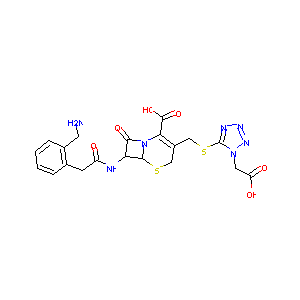Details of the Drug
General Information of Drug (ID: DMSQVD6)
| Drug Name |
Ceforanide
|
||||||||||||||||||||||
|---|---|---|---|---|---|---|---|---|---|---|---|---|---|---|---|---|---|---|---|---|---|---|---|
| Synonyms |
Ceforanido; Ceforanidum; Precef; Radacef; Bl s786; BL-S 786; BL-S786; Ceforanido [INN-Spanish]; Ceforanidum [INN-Latin]; Precef (TN); Ceforanide (USP/INN); Ceforanide [USAN:INN:BAN]; (6R,7R)-7-(2-(alpha-Amino-o-tolyl)acetamido)-3-(((1-(carboxymethyl)-1H-tetrazol-5-yl)thio)methyl)-8-oxo-5-thia-1-azabicyclo(4.2.0)oct-2-ene-2-carboxylic acid; (6R,7R)-7-({[2-(aminomethyl)phenyl]acetyl}amino)-3-({[1-(carboxymethyl)-1H-tetrazol-5-yl]sulfanyl}methyl)-8-oxo-5-thia-1-azabicyclo[4.2.0]oct-2-ene-2-carboxylic acid; (6R,7R)-7-({[2-(aminomethyl)phenyl]acetyl}amino)-3-({[1-(carboxymethyl)-1H-tetrazol-5-yl]thio}methyl)-8-oxo-5-thia-1-azabicyclo[4.2.0]oct-2-ene-2-carboxylic acid; (6R,7R)-7-[[2-[2-(aminomethyl)phenyl]acetyl]amino]-3-[[1-(carboxymethyl)tetrazol-5-yl]sulfanylmethyl]-8-oxo-5-thia-1-azabicyclo[4.2.0]oct-2-ene-2-carboxylic acid; (6R-trans)-7-(((2-(Aminomethyl)phenyl)acetyl)amino)-3-(((1-(carboxymethyl)-1H-tetrazol-5-yl)thio)methyl)-8-oxo-5-thia-1-azabicyclo(4.2.0)oct-2-ene-2-carboxylic acid; 7-(o-(Aminomethyl)phenylacetamido)-3-(((1-(carboxymethyl)-1H-tetrazol-5-yl)thio)methyl)-3-cephem-4-carboxylic acid; 7-[O-(aminomethyl)phenylacetamido]-3-[[[1-(carboxymethyl)-1H-tetrazol-5-yl]thio]methyl]-3-cephem-4-carboxylic acid; 7beta-[2-(aminomethyl)phenyl]acetamido-3-{[1-(carboxymethyl)-1H-tetrazol-5-yl]sulfanyl}methyl-3,4-didehydrocepham-4-carboxylic acid
|
||||||||||||||||||||||
| Indication |
|
||||||||||||||||||||||
| Therapeutic Class |
Antibiotics
|
||||||||||||||||||||||
| Drug Type |
Small molecular drug
|
||||||||||||||||||||||
| Structure |
 |
||||||||||||||||||||||
| 3D MOL | 2D MOL | ||||||||||||||||||||||
| #Ro5 Violations (Lipinski): 3 | Molecular Weight (mw) | 519.6 | |||||||||||||||||||||
| Logarithm of the Partition Coefficient (xlogp) | -3.2 | ||||||||||||||||||||||
| Rotatable Bond Count (rotbonds) | 10 | ||||||||||||||||||||||
| Hydrogen Bond Donor Count (hbonddonor) | 4 | ||||||||||||||||||||||
| Hydrogen Bond Acceptor Count (hbondacc) | 12 | ||||||||||||||||||||||
| ADMET Property |
|
||||||||||||||||||||||
| Chemical Identifiers |
|
||||||||||||||||||||||
| Cross-matching ID | |||||||||||||||||||||||
Molecular Interaction Atlas of This Drug
 Drug Therapeutic Target (DTT) |
|
||||||||||||||||||||||||||
|---|---|---|---|---|---|---|---|---|---|---|---|---|---|---|---|---|---|---|---|---|---|---|---|---|---|---|---|
| Molecular Interaction Atlas (MIA) | |||||||||||||||||||||||||||
References
